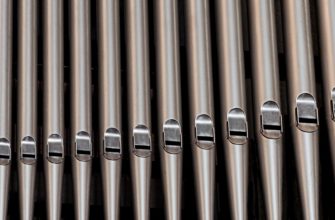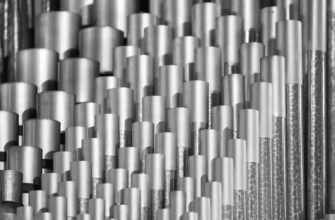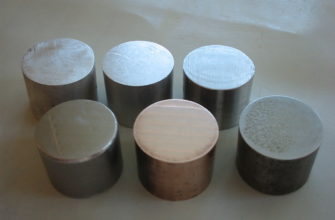316 stainless steel is a widely used alloy that offers excellent corrosion resistance, high strength and good mechanical properties. Its composition includes a combination of various elements that contribute to its unique properties and suitability for a wide range of applications.
- Density: The density of 316 stainless steel is approximately 8000 kg/m3, making it a relatively lightweight material.
- Composition: The composition of 316 stainless steel consists of iron, chromium, nickel, molybdenum and small amounts of other elements. Chromium provides corrosion resistance, while nickel enhances the ductility and toughness of the alloy. Molybdenum improves the alloy’s resistance to pitting and crevice corrosion.
- Hardness: 316 stainless steel has a hardness of around 95 on the Rockwell B scale, indicating its excellent strength and resistance to deformation.
- Mechanical Properties: AISI 316 stainless steel exhibits high tensile strength and good elongation, making it suitable for applications that require strong and durable materials. Its mechanical properties can be further enhanced through heat treatment processes.
- Thermal Conductivity: The thermal conductivity of stainless steel 316 is approximately 16.2 W/m·K, which is relatively low compared to some other metals. This property makes 316 stainless steel a suitable choice for applications that require good thermal insulation.
- Melting Temperature: The melting temperature of 316 stainless steel is around 1370-1400°C (2498-2552°F), which is within the range of other commonly used stainless steels.
One of the key advantages of 316 stainless steel is its excellent corrosion resistance. It is resistant to a variety of corrosive environments, including seawater, acids and alkalis. This makes it an ideal choice for marine applications, chemical processing equipment and medical implants.
| Property | Value |
|---|---|
| Density (kg/m3) | 8000 |
| Hardness (Rockwell B) | 95 |
| Thermal Conductivity (W/m·K) | 16.2 |
| Melting Temperature (°C) | 1370-1400 |
Overall, 316 stainless steel offers a combination of desirable properties that make it a versatile and reliable material for various industrial and commercial applications. Its high corrosion resistance, excellent mechanical properties and thermal stability make it a popular choice in industries such as aerospace, automotive and chemical processing.

Chemical Composition of 316 Stainless Steel
The chemical composition of 316 stainless steel, also known as SS316 or AISI 316, plays a crucial role in determining its mechanical properties and overall performance. This grade of stainless steel is an austenitic stainless steel alloy, which means it is able to retain its strength and toughness even at high temperatures. The presence of certain elements in its composition enhances its corrosion resistance and makes it suitable for a variety of applications.
One of the key elements in the chemical composition of 316 stainless steel is chromium. It is present in a range of 16-18%, which contributes to the alloy’s excellent corrosion resistance, especially in chloride environments. Another important element is nickel, which is present in a range of 10-14%. Nickel enhances the alloy’s toughness, ductility, and resistance to corrosion. Additionally, the presence of molybdenum, typically in a range of 2-3%, further improves the corrosion resistance of 316 stainless steel.

Density of 316 Stainless Steel
The density of 316 stainless steel, also known as 316L SS, is an important factor to consider when analyzing its composition and mechanical properties. The density of a material is defined as its mass per unit volume. For stainless steel, density is typically measured in kilograms per cubic meter (kg/m3).
The density of stainless steel 316 is approximately 8000 kg/m3. This high density contributes to its durability and stability. The melting point of 316 stainless steel falls within the range of 1400-1450°C, indicating its ability to withstand high temperatures. Additionally, its thermal conductivity is around 16.2 W/m·K, which means it can efficiently transfer heat.
In summary, the density of 316 stainless steel plays a crucial role in determining its overall properties. With a density of 8000 kg/m3, this material exhibits excellent strength, corrosion resistance, and stability. Understanding the density and other composition and mechanical properties of stainless steel 316 is essential for selecting the right material for specific applications.
Hardness and Mechanical Properties
The AISI 316 stainless steel is known for its excellent mechanical properties, making it suitable for a wide range of applications. It has a high tensile strength of around 590 MPa, which means it can withstand significant amounts of stress before deforming or breaking. This makes it ideal for structural applications where strength is essential, such as in construction or automotive industries. Additionally, the stainless steel 316 has a good yield strength of around 220 MPa, which represents the amount of stress it can withstand before permanent deformation occurs.
In terms of hardness, the 316 stainless steel has a maximum Brinell hardness of around 217 HB, making it relatively hard compared to other types of stainless steel. This makes the 316 stainless steel suitable for applications where hardness is important, such as in manufacturing machinery or equipment that undergoes abrasive processes.
It is important to note that the mechanical properties of the stainless steel 316 can vary depending on its specific composition and processing. The addition of certain alloying elements or heat treatment can significantly affect its mechanical properties, including its hardness and strength.
In conclusion, the AISI 316 stainless steel exhibits excellent mechanical properties, including high tensile strength, good yield strength, and relatively high hardness. These properties make it a versatile material for various applications, especially in industries where strength, hardness, and thermal conductivity are important factors to consider.

Thermal Conductivity of 316 Stainless Steel
The thermal conductivity of 316 stainless steel is an important property that affects its performance in various applications. To understand this property, it is necessary to consider the chemical composition and structure of the material.
Thermal conductivity refers to the ability of a material to conduct heat. In the case of 316 stainless steel, its thermal conductivity is relatively low compared to other metals, such as copper or aluminum. The thermal conductivity of 316 stainless steel is around 16.2 W/m•K at room temperature. This means that it is a poor conductor of heat compared to metals with higher thermal conductivities. However, its thermal conductivity is still higher than that of most non-metals.
It is important to consider the thermal conductivity of 316 stainless steel when designing and selecting materials for applications that involve heat transfer. For example, in heat exchangers or industrial processes that require efficient heat transfer, materials with higher thermal conductivities may be preferred. However, in certain applications where thermal insulation is desired, the relatively low thermal conductivity of 316 stainless steel can be an advantage.
Melting Point and Temperature
The melting point of a material is the temperature at which it transitions from solid to liquid form. When it comes to the melting point of AISI 316 stainless steel, it has a fairly high melting point compared to other common metals. The melting point of AISI 316 stainless steel is around 1375-1400°C (2500-2550°F). This high melting point is due to the composition of 316 stainless steel, which contains a significant amount of chromium and nickel.
Chromium and nickel are known for their high melting points, and they contribute to the overall strength and corrosion resistance of 316 stainless steel. The presence of these alloying elements helps to stabilize the austenitic structure of the steel, even at high temperatures. This property is particularly important in applications where the steel is exposed to elevated temperatures, such as in the automotive, chemical and oil and gas industries.
| Property | Value |
|---|---|
| Melting Point | 1375-1400°C (2500-2550°F) |
Corrosion Resistance
One of the key properties of 316 stainless steel is its excellent corrosion resistance. This makes it a popular choice for applications where the material will be exposed to harsh environments or corrosive substances. The increased corrosion resistance of 316 stainless steel compared to other grades, such as 304 stainless steel, is due to the addition of molybdenum in its composition. Molybdenum helps enhance the material’s resistance to corrosion, especially in chloride environments. This makes 316 stainless steel highly suitable for use in marine and coastal applications where saltwater exposure is common.
In addition to its molybdenum content, the passive film that forms on the surface of 316 stainless steel also contributes to its corrosion resistance. This film acts as a protective barrier, preventing the material from coming into direct contact with corrosive agents. As a result, 316 stainless steel can withstand a wide range of acids, alkalis, and other corrosive substances, making it ideal for use in chemical processing equipment and environments where cleanliness and hygiene are critical.

Tensile Strength and Yield Strength
Tensile strength and yield strength are important mechanical properties of any material, including 316 stainless steel. Understanding these properties is essential for determining the suitability of the material for various applications.
Tensile strength refers to the maximum amount of stress that a material can withstand before it breaks or fails. In the case of 316 stainless steel, the tensile strength is typically around 515 MPa (megapascals) or 74,741 psi (pound-force per square inch). This high tensile strength makes it suitable for applications that require a strong and durable material.
Yield strength, on the other hand, refers to the amount of stress or force that a material can withstand without undergoing permanent deformation or plasticity. For 316 stainless steel, the yield strength is typically around 205 MPa (megapascals) or 29,732 psi (pound-force per square inch). This means that the material can sustain significant stress before it starts to deform or yield.
Tensile Strength and Yield Strength of 316 Stainless Steel
| Property | Value |
|---|---|
| Tensile Strength | 515 MPa (74,741 psi) |
| Yield Strength | 205 MPa (29,732 psi) |
It is important to note that both tensile strength and yield strength can vary depending on factors such as the composition, heat treatment, and manufacturing process of the stainless steel. Additionally, these properties may also be influenced by factors such as temperature and corrosion. Therefore, it is crucial to consider these factors when selecting 316 stainless steel for a particular application.
Weldability of 316 Stainless Steel
One of the key properties of 316 stainless steel is its excellent weldability. This makes it a popular choice for applications that require welding, such as the construction of tanks, piping systems, and other structures. The weldability of 316 stainless steel is primarily due to its low carbon content, which helps in preventing carbide precipitation and subsequent intergranular corrosion.
The melting point of 316 stainless steel is approximately 1370-1400°C, which means that it requires high temperatures for welding. The chemical composition of 316 stainless steel is primarily composed of elements such as chromium, nickel, and molybdenum, which contribute to its corrosion resistance and high-temperature strength. The density of 316L stainless steel is around 8000 kg/m3, which makes it a relatively lightweight material with good mechanical properties.
- The low carbon content of 316 stainless steel promotes its weldability.
- Matching the welding process to the yield strength of the material is crucial for successful welding.
- High temperatures are required for welding 316 stainless steel due to its high melting point.
- The density of 316 stainless steel is around 8000 kg/m3, making it a lightweight material with good mechanical properties.

316L and 316Ti Variations
While 316 stainless steel is a widely used grade due to its excellent corrosion resistance and high temperature strength, there are two common variations of this alloy that offer even more specific properties: 316L and 316Ti.
316L, also known as low carbon stainless steel, is an extra-low carbon version of 316 stainless steel. The low carbon content in 316L makes it resistant to sensitization, a condition where carbides can form at high temperatures, reducing corrosion resistance. This makes 316L suitable for applications where welding is required, as it minimizes the risk of carbide precipitation. Additionally, the lower carbon content in 316L offers improved resistance to intergranular corrosion.
On the other hand, 316Ti, also known as titanium-stabilized stainless steel, contains small amounts of titanium in its composition. The addition of titanium helps to stabilize the structure and limit the formation of harmful carbides during welding, similar to 316L. However, the titanium content in 316Ti is higher than in 316L, offering even better resistance to sensitization. This makes 316Ti ideal for applications involving elevated temperatures, such as exhaust manifolds and furnace parts.
- 316L stainless steel:
- Low carbon content
- Minimizes carbide precipitation and intergranular corrosion
- Suitable for welding applications
- 316Ti stainless steel:
- Contains titanium for stabilization
- Offers enhanced resistance to sensitization
- Ideal for high-temperature applications
Density Variations in Different Forms
When discussing the density of 316 stainless steel, it is important to consider the different forms in which it can exist. For example, when in solid form, the density of 316 stainless steel is typically around 8000 kg/m^3, which is slightly higher than the density of pure water. This high density contributes to the strength and durability of stainless steel, making it a popular choice for various applications.
The density of 316 stainless steel can also vary depending on its composition. The addition of certain elements, such as nickel and molybdenum, can affect the density of the alloy. For example, 316L stainless steel, which contains a lower amount of carbon compared to regular 316 stainless steel, has a slightly lower density of around 7980 kg/m^3. This difference in density can be attributed to the reduced carbon content, which makes the alloy less dense.
- In solid form, the density of 316 stainless steel is typically around 8000 kg/m^3.
- 316L stainless steel has a slightly lower density of around 7980 kg/m^3 due to its reduced carbon content.
- Composition and form play a significant role in determining the density of 316 stainless steel.
| Property | 316 Stainless Steel Density (kg/m^3) |
|---|---|
| 316 Stainless Steel | 8000-8300 |
| 316L Stainless Steel | 7980 |

Comparative Analysis with Other Stainless Steels
In the world of stainless steels, 316 stainless steel stands out as a versatile and popular choice due to its excellent corrosion resistance and high temperature strength. But how does it compare to other stainless steels in terms of its properties and composition?
Firstly, let’s take a look at the melting point of 316 stainless steel. The melting point, or melting temperature, is the temperature at which a solid material changes into a liquid state. In the case of 316 stainless steel, it has a melting point of around 1375-1400°C (2507-2552°F). This high melting point makes 316 stainless steel suitable for applications that involve high temperatures.
- Properties of 316 stainless steel:
- Excellent corrosion resistance
- High temperature strength
- Good weldability
- Low carbon content for improved welding
- 316L yield strength: The yield strength of 316L stainless steel is approximately 170 MPa (25 ksi).
- SS 316 composition: The composition of 316 stainless steel includes elements such as chromium, nickel, molybdenum, and a small amount of carbon. It is known for its high corrosion resistance.
- Density of 316 stainless steel in kg/m3: The density of 316 stainless steel is approximately 8000 kg/m3.
- Stainless steel 316 yield strength: The yield strength of stainless steel 316 is approximately 260 MPa (38 ksi).
- 316L hardness: The hardness of 316L stainless steel can vary depending on the heat treatment, but typically falls within the range of 70-90 HRB (Rockwell B scale).
- 316L stainless steel hardness: Similar to the hardness, the hardness of 316L stainless steel can be influenced by heat treatment. It is commonly measured on the Rockwell B scale.
- Stainless steel 316 density kg/m3: The density of stainless steel 316 is approximately 8000 kg/m3, which is similar to the density of 316 stainless steel.
- 316Ti chemical composition: 316Ti, a variation of 316 stainless steel, contains additional titanium which helps to stabilize the structure at high temperatures. The chemical composition of 316Ti can vary slightly, but it typically includes elements such as chromium, nickel, molybdenum, and a small amount of carbon.
- 1.4401 material equivalent: 1.4401 is the European equivalent of AISI 316 stainless steel. The material is commonly used in various industries due to its excellent corrosion resistance and mechanical properties. It is also known by the designation X5CrNiMo17-12-2.
In conclusion, 316 stainless steel possesses unique properties such as excellent corrosion resistance, high temperature strength, and good weldability. Its composition, density, yield strength, and hardness make it a reliable choice for a wide range of applications. When comparing it with other stainless steels, it is important to consider factors such as melting point, chemical composition, and specific alloy variations to determine the most suitable stainless steel for a particular application.

Conclusion
The properties and composition of stainless steel 316 make it a versatile and highly desirable material for many industrial and commercial applications. With its high corrosion resistance, stainless steel 316 is widely used in environments where exposure to salt water, harsh chemicals, and extreme temperatures is common.
One of the key properties of stainless steel 316 is its high thermal conductivity, which makes it an excellent choice for applications that require efficient heat transfer. The thermal conductivity of SS 316 is significantly higher than other stainless steels, such as SS 304, making it ideal for heat exchangers, boilers, and other heat transfer equipment.
Furthermore, the mechanical properties of stainless steel 316, including its high tensile strength, yield strength, and hardness, make it suitable for structural and mechanical applications. Its density, which is higher than that of SS 304, also contributes to its strength and durability.
In summary, stainless steel 316L is a versatile material with excellent corrosion resistance, high thermal conductivity, and favorable mechanical properties. Its composition, which includes elements such as chromium, nickel, molybdenum, and carbon, gives it the necessary characteristics to withstand harsh environments and demanding applications.










